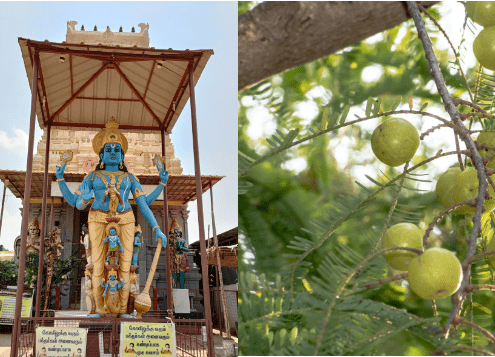Amalaki Ekadashi: A Day to Honor Vishnu and the Amla Tree

Among the many auspicious days celebrated in Hinduism, there are 2 Ekadashis each month and Amalaki Ekadashi holds a special significance. This sacred occasion, observed twice a month during the waxing and waning phases of the moon, holds profound significance for devotees seeking blessings from Lord Vishnu, the preserver god, and the revered amla (Indian gooseberry) tree. Let us delve into the essence of Amalaki Ekadashi, exploring its date, purpose, deity, and the beautiful traditions that accompany it.
Amalaki Ekadashi : The Date and Time
This year, Amalaki Ekadashi is on March 20th, 2024. However, due to the way the lunar calendar aligns with the solar calendar, the exact observance may begin on the evening of March 19th and extend into the next day. It’s always best to consult a local almanac (Panchang) for the precise timings in your region.
Purpose and Significance
The observance of Amalaki Ekadashi is believed to cleanse one’s sins and bestow divine blessings upon the devotees. It is said that observing this fast with sincerity and devotion leads to the fulfillment of desires, spiritual upliftment, and liberation from the cycle of birth and death. The core purpose of Amalaki Ekadashi is twofold:
To honor Lord Vishnu:
Ekadasis are generally considered extremely auspicious days for devotees of Vishnu. Observing a fast and offering prayers on this day is believed to appease the Lord, seeking his blessings for a happy, prosperous, and fulfilling life.
To celebrate the amla tree:
The amla tree, also known as the Indian gooseberry, holds immense importance in Ayurveda, the traditional Indian system of medicine. Revered for its potent medicinal properties and symbolic purity, the amla tree embodies good health and well-being. On Amalaki Ekadashi, devotees worship this sacred tree, seeking its blessings and expressing gratitude for its life-giving qualities.

The Fast and Its Observance
Amalaki Ekadashi is traditionally observed by undertaking a fast. Devotees abstain from all grains, cereals, legumes, and certain vegetables considered root vegetables (like onions and garlic). Some may choose a stricter observance, avoiding even certain fruits and vegetables. Here’s a general guideline for the fast:
- Parayan (Commencement):The fast typically begins on the evening before Ekadashi, after consuming a light pre-dawn meal (Satvik) devoid of grains and legumes.
- Fasting Period:Devotees abstain from all food and water throughout the Ekadashi day.
- Parana (Breaking the Fast):The fast concludes the following day (Dwadashi) after sunrise, with a simple meal consisting of fruits and permitted vegetables. It’s important to break the fast gradually, consuming easily digestible foods.
Celebrating Amalaki Ekadashi
Beyond the fast, Amalaki Ekadashi is a day filled with spiritual observances and traditions. Here’s how you can celebrate this auspicious occasion:
Puja (Worship):
- Waking up early, take a purifying bath before setting up a puja altar.
- Offer prayers to Lord Vishnu, chanting his mantras and hymns. You can use a sacred image (murti) or a simple representation like a Shaligram stone.
- Prepare a special offering (prasad) for the Lord, which could include fruits, flowers, and sweets made with permitted ingredients.
Amla Tree Worship:
- Visit an amla tree, preferably in a temple or nearby sacred space.
- Pour clean water (Gangajal) at the base of the tree.
- Offer prayers to the tree, expressing gratitude for its medicinal properties and seeking its blessings. You can also tie a sacred thread (Kalawa) around the trunk.
Spiritual Activities:
- Devote the day to meditation, chanting bhajans (devotional songs), and reading scriptures like the Bhagavad Gita.
- Listen to discourses on the significance of Amalaki Ekadashi and the virtues of Lord Vishnu.
Charity (Daan):
- Donate cloths, food, or other essential items to the underprivileged. This act of charity (Daan) is believed to bring merit and blessings on this auspicious day.
Satsang (Company of the Holy):
- Spend time with other devotees, discussing spiritual matters and sharing stories. This strengthens your connection with the community and reinforces the significance of the day.
Breaking the Fast (Parana):
- As mentioned earlier, break the fast the following day with a light and easily digestible meal. Share the prasad with your family and friends, spreading the joy and blessings of Amalaki Ekadashi.
Additional Practices:
- Some devotees may choose to observe a partial fast, consuming only fruits and permitted vegetables during the Ekadashi day.
- You can also perform an Abhishek (sacred bath) for Lord Vishnu, using milk, curd, honey, panchamrita (a mixture of five nectars), or even plain water.
- Keeping a vigil (Jagran) throughout the night is another way some devotees observe the occasion, offering continuous prayers and staying awake to heighten their spiritual awareness.
Significance and Benefits:
Observing Amalaki Ekadashi is believed to bring numerous benefits:
- Spiritual Growth:The fast and devotional practices help cleanse the mind and body, fostering spiritual growth and inner peace.
- Divine Blessings:By seeking Lord Vishnu’s blessings, devotees hope for a life filled with happiness, prosperity, and good health.
- Physical Well-being:The focus on a light and healthy diet during the fast can promote overall well-being and detoxification.
- Environmental Awareness:The reverence for the amla tree highlights the importance of protecting nature and its gifts.
Conclusion
Amalaki Ekadashi is a beautiful blend of devotion, nature worship, and personal well-being. It’s a day to connect with the divine through Lord Vishnu, appreciate the life-giving properties of the amla tree, and practice self-discipline through the fast. Whether you choose to observe the full fast or participate in simpler ways, Amalaki Ekadashi offers an opportunity for spiritual growth and reflection. So, join in the celebration, embrace the traditions, and experience the peace and blessings associated with this unique Hindu festival.
Frequently Asked Questions
- What is the significance of Amalaki Ekadashi?
Amalaki Ekadashi is significant for its spiritual benefits, cleansing one’s sins, and bestowing divine blessings upon devotees.
- When does Amalaki Ekadashi occur?
It falls on the eleventh day of the waxing moon in the Hindu calendar month of Phalguna.
- How do devotees observe Amalaki Ekadashi?
Devotees observe strict fasting, visit Vishnu temples, and engage in devotional practices to seek divine grace.
- Why is Lord Vishnu worshipped on Amalaki Ekadashi?
Lord Vishnu is worshipped as the preserver of the universe and the bestower of blessings on this auspicious day.
- What are the benefits of fasting on Amalaki Ekadashi?
Fasting purifies the body, mind, and soul, cultivates self-discipline, and deepens the spiritual connection with the divine.

